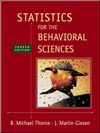| variable | anything that may take on different values or amounts
|
 |
 |
 |
| independent variable | the variable manipulated or controlled by the experimenter
|
 |
 |
 |
| dependent variable | in behavioral science, the measurement of behavior
|
 |
 |
 |
| population | a complete collection of organisms or objects having some common characteristic
|
 |
 |
 |
| parameter | a measurable characteristic of a population
|
 |
 |
 |
| sample | a subset of a population
|
 |
 |
 |
| statistic | a measurable characteristic of a sample
|
 |
 |
 |
| sampling | the process of selecting a sample from a population
|
 |
 |
 |
| unbiased sample | a sample that shows no systematic tendency relative to the population; a sample that accurately reflects the population from which it was drawn
|
 |
 |
 |
| biased sample | a sample that is unrepresentative of the population from which it was drawn
|
 |
 |
 |
| random sampling | sampling in which each population member theoretically has an equal chance of being drawn
|
 |
 |
 |
| random and independent sampling | another term for random sampling
|
 |
 |
 |
| independent sampling | another term for random sampling
|
 |
 |
 |
| sampling with replacement | sampling in which each selected individual is returned to the population before the next selection
|
 |
 |
 |
| sampling without replacement | sampling in which each selected individual is not returned to the population before the next selection
|
 |
 |
 |
| stratified random sampling | sampling in which the population is divided into groups, and random samples are taken from each group
|
 |
 |
 |
| scales of measurement | rules used to assign numbers to objects or events
|
 |
 |
 |
| measurement data | data involving a true measurement process
|
 |
 |
 |
| frequency data | data consisting of counts, totals, or frequencies
|
 |
 |
 |
| nominal scale | measurement scale assigning names or labels to different objects or events
|
 |
 |
 |
| ordinal scale | scale in which numbers serve to both identify and rank-order the objects or events
|
 |
 |
 |
| ranking | placing objects or events in order, from highest to lowest
|
 |
 |
 |
| rank-ordering | another name for ranking
|
 |
 |
 |
| interval scale | scale in which numbers serve to identify and rank-order the objects or events, and there are equal intervals between the numbers
|
 |
 |
 |
| ratio scale | interval scale with a true zero
|
 |
 |
 |
| descriptive statistics | statistics that are used to illustrate quantities of numerical observations
|
 |
 |
 |
| inferential statistics | statistical techniques that allow us to make conclusions about a larger group based on a subset of it and tell us how confident we are in our conclusions
|



 2003 McGraw-Hill Higher Education
2003 McGraw-Hill Higher Education